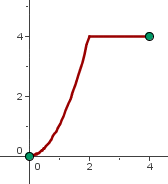Chapters
Functions are continuous if they don't have any breaking point. For example, consider the graph of  . The function doesn't change its behaviour at any point. Hence we can call this function a continuous function. Now consider the graph of
. The function doesn't change its behaviour at any point. Hence we can call this function a continuous function. Now consider the graph of  . You will see that the graph breaks at some certain points, such as
. You will see that the graph breaks at some certain points, such as  , and many more. This function is known as a non-continuous function. The continuity also depends upon the range of the function. The continuity of the function is checked on all values that are in the interval. Interval can either be closed or open. If open, then it means you need to check from the point after the starting interval point till the point which is before the ending interval point. However, if you are provided with a close interval then you have to check your function against the values that are in the interval which includes starting and ending point of the interval. A function f(x) is continuous at the open interval [a, b] if:
, and many more. This function is known as a non-continuous function. The continuity also depends upon the range of the function. The continuity of the function is checked on all values that are in the interval. Interval can either be closed or open. If open, then it means you need to check from the point after the starting interval point till the point which is before the ending interval point. However, if you are provided with a close interval then you have to check your function against the values that are in the interval which includes starting and ending point of the interval. A function f(x) is continuous at the open interval [a, b] if:
- The function is right-continuous, i.e.,

- The function is left continuous, i.e.,

If f is continuous at a closed interval [a, b], then f is bounded on that interval.

Continuity Study
The best way to find whether the function is continuous or not is by putting up limits to a specific point. Imagine a point "a" that is between the interval. The limit will approach in two directions, from the positive side to that point and from the negative side to that point. After finding both limits, check whether they are equal to each other or not. The limit will start from the starting point of the interval (supposing close interval) to the point "a" for the positive limit. In the case of the negative limit approach, the limit will start from the ending point of the interval to the point "a". If they are equal, the function is continuous and if they are not equal, that means the function isn't continuous.
Example
Study the continuity of  at the interval
at the interval  .
.
f(x) is left-continuous at  , since
, since  and polynomial functions are continuous at all of
and polynomial functions are continuous at all of  .
.
f(x) is right-continuous at  , since
, since  and polynomial functions are continuous at all of
and polynomial functions are continuous at all of  .
.
Study the continuity at  , as this is the interval of the piecewise function. For
, as this is the interval of the piecewise function. For  to be continuous, it needs to be continuous at this point.
to be continuous, it needs to be continuous at this point.



Hence, 
Thus, f (x) is continuous in the interval  .
.














Derivative of denominator is wrong
Good catch—thanks for pointing that out! We’ll double-check the derivative in that section and make any necessary corrections. Really appreciate you taking the time to flag it. 👍
Thank you
Thank you Abbas! Good luck with your studies!
With regard to the Zero Over a Number item, is there a mis-statement? It’s immediately followed by “If a number is divided by zero which means that the numerator is zero and the denominator is the number, then the result is zero.”
Hi Mark,
You’re absolutely right to raise the question — there does appear to be a misstatement in that sentence. The phrase “If a number is divided by zero, which means that the numerator is zero and the denominator is the number…” is indeed misleading and should be corrected.
To clarify:
Zero divided by a number (e.g. 0 ÷ 5) equals 0.
A number divided by zero (e.g. 5 ÷ 0) is undefined.
We’ll update the sentence to reflect the correct mathematical explanation. We appreciate you catching that and helping us improve the accuracy of the content!
There is more than one size of infinity, though. What if you multiply the infinity of the whole numbers (Aleph-0) by the infinity of the real numbers (fraktur-c)?
Thanks a lot to you for this essentiol article.
Hi Piyash! Thanks for your comment, great to hear that you found this useful!
Very nice